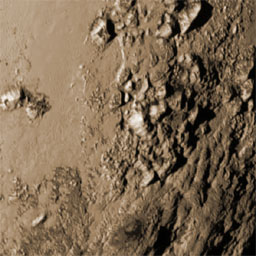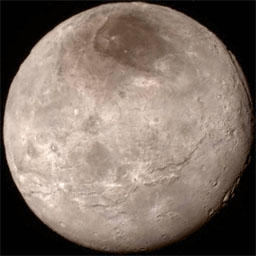Celebrate New Horizons by
Observing Pluto Yourself
Updated July 16, 2015
The New Horizons spacecraft flew by Pluto on July 14th,
and the first close-up images have been released. We are seeing Pluto clearly for the first time in
history! Its not too late to go out and have a look at it yourself to
mark the occasion. See below for details.
With the Dawn spacecraft orbiting Ceres, Rosetta exploring a comet,
and New Horizons revealing Pluto, this is a banner year for the
exploration of the solar system. It is a remarkable time to be alive. I
vividly recall sitting in an empty classroom in the middle of the night
in 1989,
watching the images of Neptune come down from Voyager 2 over a
university TV feed. Until then, in all of human history, nobody had ever
seen Neptune and its moons up close. I will never forget seeing those
bizarre "cantaloupe" images of Triton for the first time. My
jaw was on the floor. Now, as Pluto grows daily in the New Horizons
camera, there are already hints of interesting new terrain. The first
textbooks on Pluto will soon be written. This time we
are living in today is also going to be remembered as the end of an age.
With the exploration of Pluto and Ceres, every well-known major body in
our solar system will have been visited by spacecraft. Fifty-three years
after the first Mariner flyby of Venus, most of the solar system will
have been revealed.
|
 The latest picture from New Horizons! This is
the first close-up flyby image. Click
to see the much larger, full scale image and story. Color is
approximate. |
What better way to celebrate New Horizons than to observe Pluto for yourself!
On July 6, 2015 Pluto was at opposition (the peak of the Pluto observing
season). The moon was New on the 16th, and will slowly return to the
evening sky afterward. Pluto will remain well placed for observation in
a moonless sky until the night of the 22nd.
What do you need to observe Pluto?
Pluto will be magnitude 14.1, which is pretty faint. It can be glimpsed
visually in a 6-inch (15 cm) telescope by an experienced observer when high in
the sky as seen from a dark site. Most people are going to require at least an
8-inch (20 cm) scope to see it. Larger-aperture telescopes will improve it's
visibility considerably. But even the most modest telescope equipped with a
camera should be able to record it, even from a light-polluted location.
|
 Today's
historic image of Pluto's moon, Charon. Click
to see the much larger, full scale view. |
What can you expect to see?
 Pluto
will look like a faint star. It's moon Charon is 16th magnitude and only
0.7" away, so it is not likely to be visible, nor is it likely to appear on
images. One thing to look for that will make Pluto stand out is motion. In fact,
if you don't have a detailed computer-generated chart showing Pluto and the
surrounding stars, this may be the only way to figure out which "star"
is Pluto. It will move very slowly, by about 4 seconds of arc per hour. If there
happens to be two or more stars nearby, you may be able to detect it's motion in
a couple of hours, and if you come back the next night, its motion should be
obvious. Thankfully, Pluto is currently in a rich star field. Make a sketch of
the star field, paying particular attention to the relative positions of the
stars. Then come back later and compare your sketch. The star that moved is
Pluto. Pluto
will look like a faint star. It's moon Charon is 16th magnitude and only
0.7" away, so it is not likely to be visible, nor is it likely to appear on
images. One thing to look for that will make Pluto stand out is motion. In fact,
if you don't have a detailed computer-generated chart showing Pluto and the
surrounding stars, this may be the only way to figure out which "star"
is Pluto. It will move very slowly, by about 4 seconds of arc per hour. If there
happens to be two or more stars nearby, you may be able to detect it's motion in
a couple of hours, and if you come back the next night, its motion should be
obvious. Thankfully, Pluto is currently in a rich star field. Make a sketch of
the star field, paying particular attention to the relative positions of the
stars. Then come back later and compare your sketch. The star that moved is
Pluto.
My early New Horizons celebration image of Pluto is on the right. It
was obtained remotely with iTelescope
T30 on June 28.
How to find Pluto?
Various web sites and magazines supply charts showing the motion of Pluto over
time. But unless you really want a challenge, I can't recommend using these.
These charts often don't have faint enough stars for finding the field and
require you to interpolate the position between the marked positions at the
given times, which is often further complicated by adjusting for your time zone.
Software can solve these problems by making a chart for the exact time you want
to observe. Better yet is a chart that exactly matches the magnitude limit
of your telescope under the expected observing conditions. The best finder
charts will also match the orientation of the view in your eyepiece and get you
to the right field via a similar chart matched to your finding device. SkyTools
3 is designed to do this. Another advantage of good charts is that you can
be certain that you found Pluto without waiting to see if it moves, especially
if you overlay a Digital Sky Survey Image on the chart.
Observing tips
Make sure to look for Pluto before the moon rises. The other thing to
consider is that the higher Pluto is in the sky the better. So try to observe it
when it is close to crossing the meridian. How faint you can see depends on the
magnification of the eyepiece you use, so Pluto may not be visible in your
lowest power eyepiece. But you should start with a low power eyepiece to locate
the correct field, then switch to higher magnification to spot Pluto.
Your latitude will affect
how high Pluto gets. The more to the south you are the better. For observers at
50N Pluto will only reach an altitude of 20o. This will make it much
more difficult to observe, which means you will need better sky conditions and a
larger telescope. From 40N it will be better -- 30o above the
horizon. But even then observers will still be looking through twice as much air
than if it were overhead. As seen from the equator, Pluto will be much higher --
nearly 60o. The best is from 30S where it will pass nearly overhead.
This would be a great time for observers at southern latitudes to try observing
Pluto in smaller instruments or to attempt the very difficult challenge of
detecting Charon.
About SkyTools
SkyTools uses a scientific
model of your telescope and observing conditions to predict when Pluto is best
visible for you, or whether or not you can expect to see it at all in your
telescope. I used it in writing this article to explore how latitude affects how
difficult Pluto will be to observe, how large of a telescope is needed, when
Pluto will be best visible, and the effect of the moon. SkyTools also makes very
easy to use finder charts that are custom generated just for your telescope and
observing conditions.
Calendar
Pluto is at opposition on July 6
Moonless Pluto observing begins on the evening of July 6
New Horizons flyby July 14
Last night to observe
Pluto in a moonless sky this month July 22
Links New
SkyTools 3
|